More about Azure Cost Management
- Azure Data Box Pricing and 7 Tips to Reduce Your Cost
- Azure Disk Storage Pricing and Performance vs. Azure Files and Azure Blob Storage
- Azure Cost Management: 5 Ways to Optimize Your Costs
- Azure Cost Analysis: A Practical Guide
- Find and Delete Unused Azure Disks to Reduce Azure Storage Costs
- Azure SQL Pricing Simplified
- Azure Blob Storage Pricing: The Complete Guide
- Azure Disk Pricing: Understanding Your Options
- Hidden Azure Data Transfer Costs: Where They Come from and What to Do About Them
- Azure Pricing Calculator:
The First Step to Saving on Azure - Azure TCO Calculator: How to Reduce Your Cloud Bill
- Azure Storage Pricing: Blobs, Files, Tables and Managed Disks
- Azure Cost Optimization: 12 Ways to Save on Azure
- Azure Block Storage and Azure Object Storage: Features, Benefits, and Solutions
- Azure Tiers Storage Better with Cloud Volumes ONTAP
- Storage Deduplication, Compression and More NetApp: Storage Efficiencies in Azure
Subscribe to our blog
Thanks for subscribing to the blog.
April 17, 2022
Topics: Cloud Volumes ONTAP AzureStorage EfficienciesElementary9 minute read
Azure cost management is an important topic for anyone responsible for managing workloads in Azure. It is also the name of a free Azure service that helps visualize and forecast Azure costs, identify anomalies, and find optimization opportunities for Infrastructure as a Service (IaaS) and Platform as a Service (PaaS) products in the Azure cloud.
In this post, we’ll explain what the Azure Cost Management service provides, how it works, and which other Azure services can help you understand and reduce your cloud costs.
In addition, we’ll show how NetApp Cloud Volumes ONTAP can help reduce storage costs for your Azure deployments.
In this article:
- What is the Azure Cost Management Service?
- What Insights Does Azure Cost Management Provide?
- 5 Ways to Optimize Azure Costs with Azure Cost Management
- Azure Cost Management
- Reducing Azure Store Costs with Cloud Volumes ONTAP
What is the Azure Cost Management Service?
Azure Cost Management is provided as part of the Azure portal, and provides information about ongoing utilization and cost of your Azure services and Azure Marketplace offerings. The service can also monitor and provide insights into AWS usage and costs, in a multi-cloud setup.
Unlike billing reports, which tell you how much Azure is billing for each service, Cost Management reports help you understand your costs, identify spending anomalies, and find opportunities for optimization.
Key features of Azure Cost Management
- Always on—continuously monitors and reports on activity in Azure
- Integrates with Azure Advisor—displays tailored recommendations for price optimization, such as opportunities to move to reserved instances, rightsizing and idle resources.
- Customization—provides cost management APIs, allowing you to explore cost and usage data programmatically and create customized filters that let you create unique views of the data in your internal systems.
- BI integration—offers a Microsoft Power BI connector, letting you export cost and usage data to Power BI and perform in-depth BI analysis.
What Insights Does Azure Cost Management Provide?
Azure Cost Management allows you to set budgets for your Azure activity, and can answer questions like:
- What will our costs be for the current month? How much have we spent so far and are we on track to meeting our budget?
- Are any Azure services showing anomalous spend? If so, what is causing the anomaly and how can we resolve it?
- Why is the latest invoice different than we expected? Why did an Azure invoice exceed the expected amount, or why were specific services billed more or less than expected?
- How much should we bill to each department? If your organization charges back cloud costs to specific departments or groups, Cost Management can help you understand how much to charge each group based on their usage.
5 Ways to Optimize Azure Costs with Azure Cost Management
Azure Cost Management
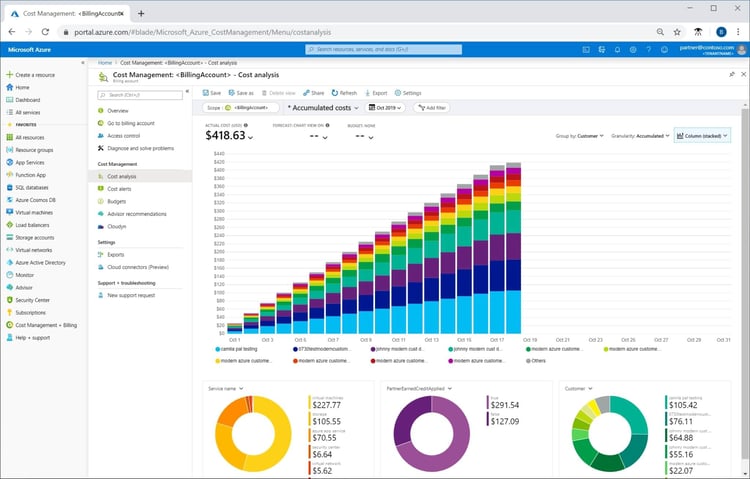 Image Source: Azure
Image Source: Azure
Azure Cost Management + Billing is a suite of tools from Microsoft that helps you analyze, manage, and optimize the cost of workloads running in the cloud. Cost Management also uses Azure management groups, budgets, and recommendations, to help organize your costs and plan how to reduce them.
Azure Cost Management provides advanced analytics that show your organization's cost and usage patterns over time. The cost management report shows usage-based costs incurred by Azure services and third-party marketplace products. The pricing shown is the actual pricing in your Azure account, based on negotiated discounts and taking into account resource reservations and Azure Hybrid Benefit discounts. However, note that other charges such as support costs and taxes are not shown in the reports.
These reports help you understand your spending and resource usage, spot anomalies in your spending, and leverage predictive analytics to estimate your future costs.
Azure Cost Analysis
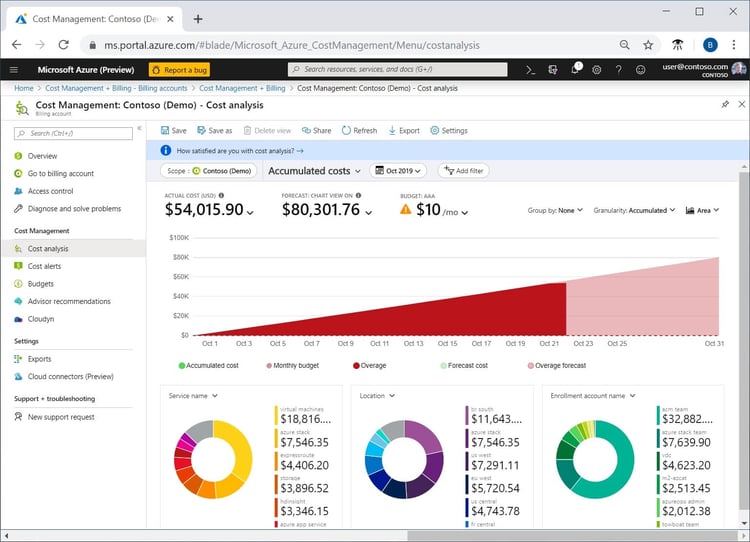 Image Source: Azure
Image Source: Azure
You can use Azure Cost Management's Cost Analysis tool to analyze details of your Azure spending.
This tool allows you to accurately investigate all costs and perform grouping and filtering across resources. Use it to check the current cost of a service or find out why your bill is higher than expected.
You can use filters on the Cost Analysis dashboard to view your expenses by:
- Scope (which Azure resources to include in the analysis - management group, subscription, or resource group)
- Time (filter by day, week, month, year, etc.)
- Granularity (can be set to cumulative, daily, or monthly)
- Group By (how to group the resources for planning and estimation - resource group, resource type, label, etc.)
Another useful report is Cost by Resource. This shows a graph of the most expensive resources, allowing you to investigate them and see if they are needed and if they can be optimized or scaled down. Alternatively, you can create your own custom filters to slice and dice cost data in different ways.
Azure Budgets
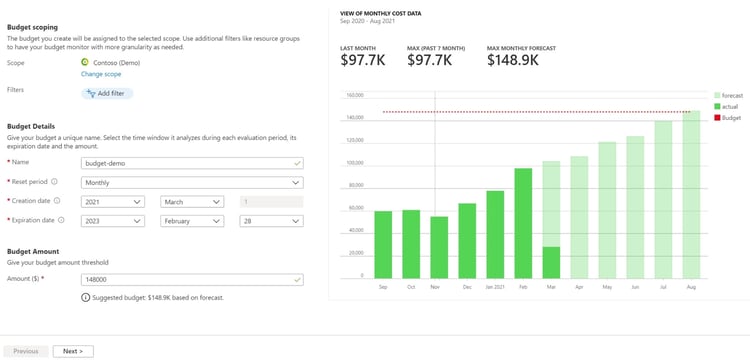 Image Source: Azure
Image Source: Azure
Azure Cost Management lets you create budgets for your Azure subscriptions, to align cloud spending with your actual organizational budgets.
When you create a new budget in your Azure subscription, you need to give it a name, set an amount, choose a time period (month, quarter, year, etc.) and choose a start and end date.
The Azure Budgets feature lets you:
- Define budgets.
- Set up notifications when Azure spend reaches a certain percentage of the budget.
- Continue receiving alerts when a resource exceeds the budget within a certain period of time.
- Proactively monitor spending and see how cloud usage aligns with budgets.
Azure Price Calculator
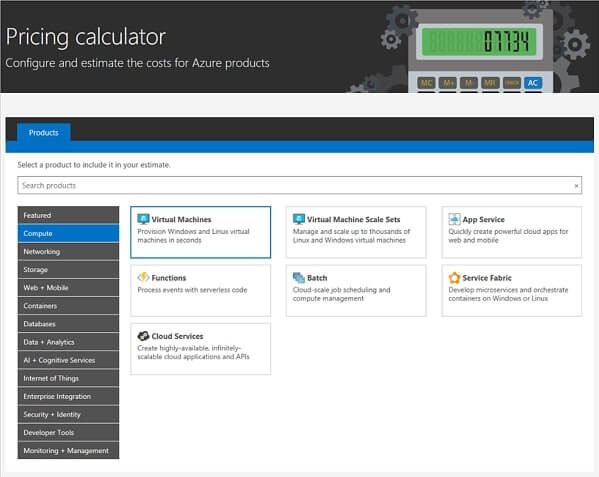 Image Source: Azure
Image Source: Azure
The Azure calculator is used to estimate the cost of Azure services. Find the Azure service or resource you are interested in and select details and settings specifying how you want to run it in Azure. The calculator provides an estimate of the cost of services based on the details selected.
You can use the calculator to get a quote for services you want to use in a solution on Azure, in order to estimate the cost of potential Azure usage ahead of time. Another use of the calculator is to investigate alternatives to your current deployment, to see if a different setup in Azure will be more cost effective.
Azure Advisor
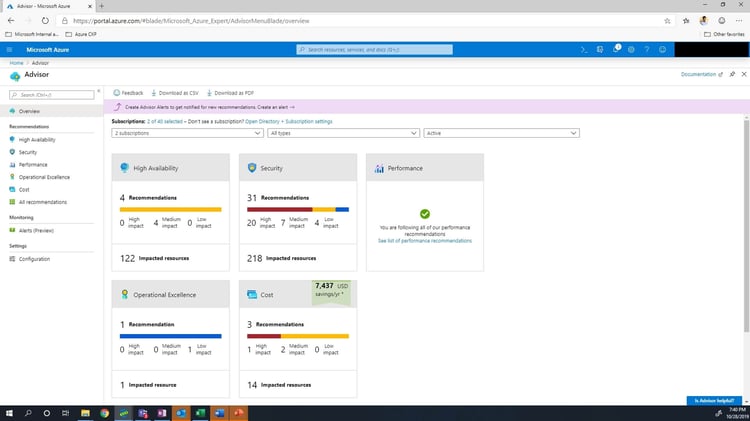 Image Source: Azure
Image Source: Azure
Advisor is a personalized cloud advisor that helps you follow best practices for optimizing your Azure deployment. It analyzes resource configuration and usage telemetry, and recommends solutions that can help improve cost-effectiveness, performance, reliability, and security of Azure resources.
Azure Advisor provides:
- Analyzing your cloud deployment and identifying opportunities to reduce cost or improve performance, reliability, or security.
- Best practice recommendations personalized for your specific Azure resources and usage.
- Specific, suggested actions to implement the recommendations.
Reducing Azure Storage Costs with Cloud Volumes ONTAP
NetApp Cloud Volumes ONTAP, the leading enterprise-grade storage management solution, delivers secure, proven storage management services on AWS, Azure and Google Cloud. Cloud Volumes ONTAP supports up to a capacity of 368TB, and supports various use cases such as file services, databases, DevOps or any other enterprise workload, with a strong set of features including high availability, data protection, cloud automation, Kubernetes integration, and more.
In particular, Cloud Volumes ONTAP provides storage efficiency features, including thin provisioning, data compression, and deduplication, reducing the storage footprint and costs for your Azure deployments by up to 70%.

Azure cost management is a broad topic. To optimize your costs, you should have a good understanding of Azure pricing models and options across the services you heavily use. Read our additional articles below for information that will help you understand and optimize cloud costs on Azure.
Azure Cost Optimization
Azure provides several important pricing options that can help you save costs: reserved instances, spot instances, Azure Hybrid Benefit (the ability to save move your Microsoft licenses from on-premises machines to Azure), dev/test pricing, and AWS price matching.
Understand if and when you can use these options to generate substantial reductions in your cloud bill. Also learn best practices that can help you improve utilization and optimize cloud usage: right-sizing VMs, switching to B-series VMs or containers, moving to elastic databases, and more.
Read more: Azure Cost Optimization: 12 Ways to Save on Azure
Azure Storage Pricing
Storage is a significant part of cloud costs for most users of Microsoft Azure. However, each storage service has its own pricing model and storage tiers, and pricing can quickly get complex.
Get a quick overview of Azure’s five core storage services, understand each service’s pricing model, and see concise tables that demonstrate pricing for common scenarios.
Read more: Azure Storage Pricing: Blobs, Files, Tables and Managed Disks
Azure Blob Storage Pricing
Azure blob storage is possibly the most common Azure service, and its pricing can be difficult to understand. It depends on multiple factors including types of storage accounts in Azure, types of blob storage, storage tiers, and redundancy options. Gain an in-depth understanding of these factors and how to calculate and forecast your storage costs.
Read more: Azure Blob Storage Pricing: The Complete Guide
Azure SQL Pricing
Azure SQL provides the popular Microsoft SQL server as a Platform as a Service (PaaS) offering. There are multiple deployment models and service tiers, adding up to as many as 18 flavors of the Azure SQL service. To add to this complexity, there are two different pricing models you can choose from: Database Transaction Units (DTU) and vCores.
To avoid getting lost in the huge number of pricing tables, start with a quick overview of Azure SQL service options, and a few pricing examples across the most common scenarios. This will make it easier when you dive into Azure’s official pricing and use the price calculator to compute your actual Azure SQL costs.
Read more: Azure SQL Pricing Simplified
Azure Storage Efficiencies
Learn how Cloud Volumes ONTAP can help you achieve significant storage efficiencies and cost savings, for both premium and standard Azure storage. Cloud Volumes ONTAP uses a combination of techniques including compression, deduplication, data compaction, thin provisioning to ensure you pay for your true on-demand capacity, efficient and instant snapshots, and near-zero-capacity volume cloning.
Read more: ONTAP Cloud for Azure: Taking Storage Efficiency to the Next Level
Azure Disk Pricing: Understanding Your Options
Azure managed disks are virtual storage volumes attached to Azure virtual machines. Virtual disks can be a major part of your spend on Azure if you have a large number of VMs. You have to understand what each type of virtual disk provides, and the cost structure for virtual disks when planning your Azure budget.
Azure provides several types of managed disks: regular HDD drives, standard solid state drives (SSD), premium solid state drives, and ultra disks. Disks are priced at a flat monthly rate (depending on disk type), with a separate charge per 10,000 transactions.
Learn about the Azure disk pricing structure, and how to choose the disk that suits your workloads.
Read more: Azure Disk Pricing: Understanding Your Options
Azure TCO Calculator: How to Reduce Your Cloud Bill
Azure total cost of ownership (TCO) calculator is a cost management tool that enables you to estimate the cost of migrating your workloads to Azure and predict your potential savings for existing workloads.
Consider using the TCO when evaluating your usage of the Azure cloud. TCO is key to understanding the real cost of your projects and measuring your return on investment (ROI).
This post reviews the importance of TCO measurement in cloud projects, and how to use the Azure TCO Calculator to understand your real costs and ROI.
Read more: Azure TCO Calculator: How to Reduce Your Cloud Bill
Azure Cost Calculator: The First Step to Saving on Azure
Azure Cost Calculator is a tool you can use to estimate the cost of Azure services. You can customize these estimates with personal configurations for greater accuracy, and monitor the estimates through a central dashboard.
This post explains the structure of the Azure pricing model and shows how to estimate your costs with the cost calculator.
Read more: Azure Cost Calculator: The First Step to Saving on Azure
Hidden Azure Data Transfer Costs: Where They Come from and What to Do About Them
Network data transfer charges could impact your monthly cloud bill significantly if your Azure resources are not planned and deployed to optimize these costs. This blog will focus on helping readers identify the hidden data transfer charges on Azure, which could otherwise be skipped unintentionally during the planning phase. Tips and tricks to optimize this cost will be discussed in detail. The blog will also focus on Cloud Volumes ONTAP’s data-efficient snapshot feature that help customers reduce the Azure data transfer costs further.
Read more: Hidden Azure Data Transfer Costs: Where They Come from and What to Do About Them
Find and Delete Unused Azure Disks to Reduce Azure Storage Costs
You may be paying higher Azure storage costs than necessary because of the high number of virtual hard disks (VHDs) that have been provisioned in your account but aren’t being used. These unused disks wind up piling up during migrations, creating backups, or during diagnostic procedures. Whatever the cause, these disks will continue to rack up charges, sometimes without users even being aware that they are paying for them. A quick and easy way to reduce your monthly Azure storage costs is to identify and delete such unused VHDs.
This post offers detailed instructions on how to delete both managed and unmanaged Azure disks from your Azure account, via two methods: the Azure portal interface or through scripted PowerShell commands.
Read more in Find and Delete Unused Azure Disks to Reduce Azure Storage Costs
See Additional Guides on Key IaaS Topics
Together with our content partners, we have authored in-depth guides on several other topics that can also be useful as you explore the world of IaaS.
AWS EBS
Authored by NetApp
- AWS EBS Ultimate Guide & 5 Bonus Features to Try
- 3 Tips for Amazon EBS Optimized Performance
- AWS EBS Volumes: How to Optimize Performance and Cost
AWS EFS
Authored by NetApp
- AWS EFS: Is It the Right Storage Solution for You?
- AWS File Sharing with AWS EFS
- EFS Performance Do’s and Don’ts
AWS FSx
Authored by NetApp
- AWS FSx: 6 Reasons to Use It in Your Next Project
- FSx for Windows: An In-Depth Look
- AWS FSx Pricing Explained with Real-Life Examples
